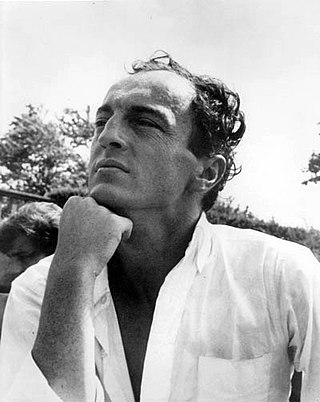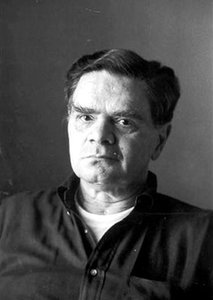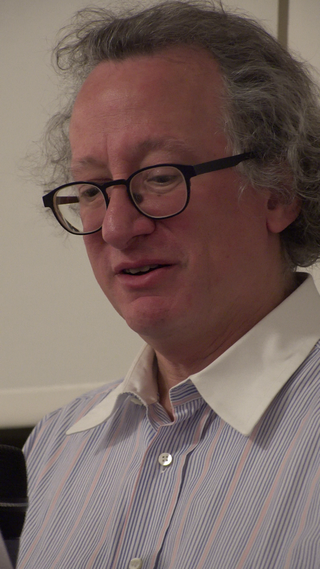
John Lawrence Ashbery was an American poet and art critic.

Francis Russell "Frank" O'Hara was an American writer, poet, and art critic. A curator at the Museum of Modern Art, O'Hara became prominent in New York City's art world. O'Hara is regarded as a leading figure in the New York School, an informal group of artists, writers, and musicians who drew inspiration from jazz, surrealism, abstract expressionism, action painting, and contemporary avant-garde art movements.
The New York School was an informal group of American poets, painters, dancers, and musicians active in the 1950s and 1960s in New York City. They often drew inspiration from surrealism and the contemporary avant-garde art movements, in particular action painting, abstract expressionism, jazz, improvisational theater, experimental music, and the interaction of friends in the New York City art world's vanguard circle.

Raymond Roussel was a French poet, novelist, playwright, musician, and chess enthusiast. Through his novels, poems, and plays he exerted a profound influence on certain groups within 20th century French literature, including the Surrealists, Oulipo, and the authors of the nouveau roman.

James Marcus Schuyler was an American poet. His awards include the Pulitzer Prize for Poetry for his 1980 collection The Morning of the Poem. He was a central figure in the New York School and is often associated with fellow New York School poets John Ashbery, Frank O'Hara, Kenneth Koch, and Barbara Guest.

Harry Mathews was an American writer, the author of various novels, volumes of poetry and short fiction, and essays. Mathews was also a translator of the French language.

Mark Ford is a British poet. He is currently Professor of English in the Department of English Language and Literature at University College London.
Charles North is an American poet, essayist and teacher. Described by the poet James Schuyler as “the most stimulating poet of his generation,” he has received two National Endowment for the Arts Creative Writing Fellowships, a Foundation for Contemporary Arts Grants to Artists award (2008), four Fund for Poetry awards, and a Poets Foundation award.

Ron Padgett is an American poet, essayist, fiction writer, translator, and a member of the New York School. Great Balls of Fire, Padgett's first full-length collection of poems, was published in 1969. He won a 2009 Shelley Memorial Award. In 2018, he won the Frost Medal from the Poetry Society of America.

William Craig Berkson was an American poet, critic, and teacher who was active in the art and literary worlds from his early twenties on.
Archie Rand is an American artist from Brooklyn, New York, United States.

Kenward Gray Elmslie was an American author, performer, editor and publisher associated with the New York School of poetry.
Susanna J. Coffey is an American artist and educator. She is the F. H. Sellers Professor in Painting at the School of the Art Institute of Chicago and lives and works in New York City. She was elected a member the National Academy of Design in 1999.
The Tibor de Nagy Gallery is an art gallery located on Rivington Street in the Lower East Side neighborhood of Manhattan.
The Sienese Shredder was an annual journal of art, literature, design, poetry, and music that was published between 2006 and 2010. In addition to written and visual content, each issue contained an audio CD.

Barry Schwabsky is an American art critic, art historian and poet. He has taught at the School of Visual Arts, Pratt Institute, New York University, Yale University, and Goldsmiths College, among others.
Jane Freilicher was an American representational painter of urban and country scenes from her homes in lower Manhattan and Water Mill, Long Island. She was a member of the informal New York School beginning in the 1950s, and a muse to several of its poets and writers.
Myron Stout was an American abstract painter whose geometric paintings and drawings bridged the styles of Abstract Expressionism and Minimalism.
Nomad was an avant-garde literary magazine edited and published in Los Angeles between 1959 and 1962 by Anthony Linick and Donald Factor. The two were particularly drawn to the poetry and writing style of the Beat Generation, who wrote of their own frequently chaotic lives.
Eric Brown is a painter, art advisor, and editor. He began his career at Tibor de Nagy Gallery in New York, New York, where he became co-owner and director. In 2017, Brown left his position at Tibor de Nagy Gallery to work independently as an art advisor and painter, and to pursue a degree in divinity.









